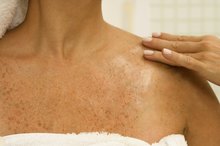Information on Vitiligo in Babies
Vitiligo is a disease in which the skin stops producing melanin, a pigment that determines the color of skin, hair and eyes. Small, irregular white patches appear on the skin. Over time, they can grow larger and spread. More than half of all vitiligo cases appear between the ages of 10 and 30, but it can develop in infants, and sometimes babies are born with it, according to the American Vitiligo Research Foundation.
Symptoms
The main symptom of vitiligo is the milky white patches that form on the skin because of pigment loss that occurs when the cells that produce melanin die or stop producing pigment. Other symptoms may include premature whitening of the hair, loss of color in the tissues lining the inside of the mouth or loss of color--or change in color--of the retina in the eye. Skin texture and sensation usually remains normal.
Causes
Skin Discoloration in Children
Learn More
The exact cause of vitiligo is unknown, but it seems to be a hereditary disease that is triggered by stress, exposure to phenols (a chemical present in many consumer products) or exposure to other environmental factors not yet known. Vitiligo often occurs with other autoimmune diseases like rheumatoid arthritis, type 1 diabetes, pernicious anemia and thyroid problems. According to the Vitiligo Support International Inc., approximately 20 percent of patients have a family member with vitiligo, but only 5 percent to 7 percent of children will get vitiligo even if one of their parents has it.
Treatment
While there’s no cure for vitiligo, there are several treatments that focus on stopping the disease from spreading and on restoring pigmentation. The earlier treatment begins, the more successful it is, and children usually respond very well.
Some treatments used on children include the use of an ointment called Protopic, the application of topical steroids and the use of ultraviolet lights. Protopic suppresses the immune system, allowing the cells that produce melanin to return. It’s available in a .03 percent strength for children.
Topical steroids can also be prescribed, and may be used alone or along with light therapy. Narrowband UVB is considered the “gold standard” of treatment in cases where more than 20 percent of the body is affected. Narrowband UVB uses ultraviolet light to increase the production of cells that make melanin. According to Vitiligo Support International Inc., light therapy can’t be used on infants, but it can be used on children who are old enough to stand still and keep goggles on.
Finding a Doctor
How to Use Selsun Blue for Sunspots
Learn More
Infants should be seen by a dermatologist, a doctor who specializes in treating skin problems. In order to find a doctor with the right experience, you need to ask questions before you make an appointment. Ask the doctor how many vitiligo patients he’s treated, and how many of his patients were children. If you live in a remote area, you may not be able to find a doctor who has ever treated this disease. In that case, ask the doctor if he’s willing to work with you if you bring him information.
Find out what vitiligo treatments your doctor offers. If he isn’t prescribing current treatments, don’t make an appointment. Instead, look for another doctor. According to Vitiligo Support International Inc., you should also make sure your doctor has a Wood's lamp, which is a lamp that uses ultraviolet light to help diagnose skin problems like vitiligo.
Educate Yourself
It’s important to educate yourself about vitiligo because many doctors don’t know much about it. You need to be your child’s advocate. Ask to have your child’s thyroid tested because vitiligo is often linked to thyroid problems. Request that your doctor use a Wood’s light to help make a diagnosis. A Wood’s light will reveal white spots, including those that can’t yet be seen in regular light. If the doctor isn’t confident about a vitiligo diagnosis, ask about having a biopsy done. If your doctor does recommend a specific treatment, ask about possible side effects. Get written instructions. Don’t leave your child’s treatment in someone else’s hands.
Related Articles
References
- American Vitiligo Research Foundation: Questions About Vitiligo
- Vitiligo Support International Inc.: Just for Parents
- American Vitiligo Research Foundation: Vitiligo Signs & Symptoms
- Vitiligo Support International Inc.: Genetics & Incidence
- Vitiligo Support International Inc.: Vitiligo Treatments and Research
Resources
Writer Bio
Lani Thompson began writing in 1987 as a journalist for the "Pequawket Valley News." In 1993 she became managing editor of the "Independent Observer" in East Stoneham, Maine. Thompson also developed and produced the "Clan Thompson Celiac Pocketguides" for people with celiac disease. She attended the University of New Hampshire.








